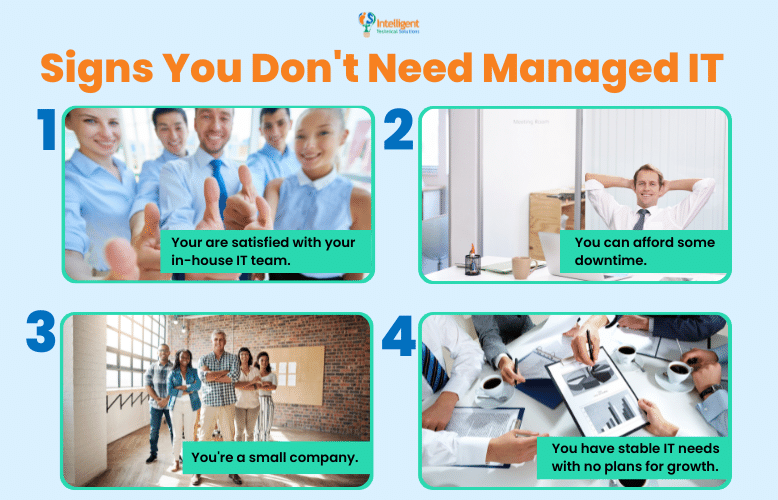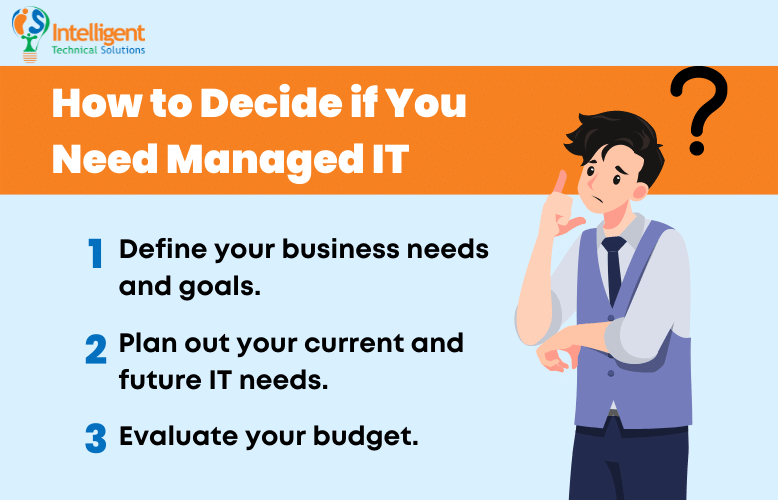4 Signs You Don’t Need Managed IT (& 3 Easy Alternatives)
November 16th, 2022 | 4 min. read
%20(73).jpg)
Managed IT is a service many businesses find useful because it promises peace of mind.
But the truth is only some companies need Managed IT.
As a Managed IT service provider, we at Intelligent Technical Solutions (ITS) know who truly gets the most out of Managed IT—and who doesn’t.
Depending on your industry and business size, or even just how much time and effort you want to put into maintaining your network infrastructure, Managed IT may be completely different from what you need.
4 Signs You Don't Need Managed IT
So, before spending thousands on a new managed service provider (MSP), here are some signs you’re better off with an alternative service.

Read: “Everything You Need to Know About Managed IT”
1. You are satisfied with your in-house IT team.
Don’t fix what’s not broken. If you have an in-house IT team that meets your day-to-day and long-term needs, then you probably don’t need Managed IT. While there are some downsides to in-house IT teams, your company’s IT network is in good hands when you have competent and efficient staff.
2. You can afford some downtime.
In-house IT teams and break-fix companies aren’t on-call 24/7. You’ll have to work around the issue if anything happens outside of regular office hours instead of getting it fixed immediately.
This gap in IT support might be perfectly acceptable for some companies where tech isn’t as much of a focal point in business productivity.
Maybe you don’t have any critical systems that need to be up and running 24/7, or tech downtime doesn’t affect your bottom line. If you’re in this situation, then Managed IT may not be for you.
3. You’re a small company.
According to Matt Philips, ITS Director of Sales, if you’re a company with around 4-6 computers and no servers, then Managed IT might not be the right fit.
Managed IT is designed to make it easy to secure and manage medium to large IT networks. Managed IT may be overkill for a small company without complex IT needs.
4. You have stable IT needs with no plans for growth.
If you’re comfortable where you are and aren’t in a field that follows IT regulations, then other IT solutions may work better with your organization.
Ed Griffin, an ITS Partner, said it best:
“[Managed IT’s] value is demonstrated when things are crazy. When you know there are highly ambitious business objectives to pursue, then we can shine. Because then all of our scalability, expertise, diligence, and professionalism comes to bear in those cases.”
3 Easy Alternatives to Managed IT
So if Managed IT isn’t for you, what other options do you have?
1. In-house IT
 The first alternative is having an in-house team working on your systems. In-house IT can be an excellent option for small businesses and startups that don’t need the level of support provided by an MSP. With small teams and straightforward IT needs, you can get away with having only one or two in-house personnel.
The first alternative is having an in-house team working on your systems. In-house IT can be an excellent option for small businesses and startups that don’t need the level of support provided by an MSP. With small teams and straightforward IT needs, you can get away with having only one or two in-house personnel.
Having in-house IT can also be expensive and time-consuming if done wrong, however.
It’s important to have people who know what they’re doing and understand the various technologies involved in running an office network.
From managing desktops, laptops, tablets, and smartphones to maintaining servers, and from monitoring devices for slow Internet speeds to protecting against security threats such as viruses or ransomware attacks, you need a team of experienced professionals you can trust.
2. Break-fix IT
 The second alternative to Managed IT is break-fix IT. It’s the most basic kind of IT support and was common in the earlier years of technology. You hire someone to solve an IT problem that pops up, they come over, and you pay for their time and the cost of materials.
The second alternative to Managed IT is break-fix IT. It’s the most basic kind of IT support and was common in the earlier years of technology. You hire someone to solve an IT problem that pops up, they come over, and you pay for their time and the cost of materials.
There’s no monthly fee, salaries, or 401Ks—just a straightforward bill.
Break-fix IT is a good option for small businesses with little tech infrastructure. It’s also relatively cheap and can be an entry point for small businesses that might not know what to expect with a managed service.
However, you won’t have anyone to plan for problems before they happen.
It can be stressful and confusing if you’ve never had to deal with an emergency system failure. You might have to scramble to find someone who can help you out or dig up old documentation from years past so that you can troubleshoot the issue yourself.
3. Co-managed IT
 If you already have an in-house IT team but have difficulty hiring more IT specialists and want Managed IT while retaining your current staff, then Co-managed IT is for you.
If you already have an in-house IT team but have difficulty hiring more IT specialists and want Managed IT while retaining your current staff, then Co-managed IT is for you.
Co-managed IT is a service model that combines in-house IT and Managed IT by letting you outsource chosen IT tasks to an MSP while still allowing you to keep an on-site team.
This hybrid solution provides the benefits of managed services without requiring you to surrender control of your IT operations completely.
How to Decide if You Need Managed IT
Managed IT is a perfect solution for certain businesses, but it’s not a one-size-fits-all solution. If you’re unsure whether Managed IT will work for your business, take some time to go through the following steps.

1. Define your business needs and goals.
Your technological needs are closely entwined with your business needs and goals. Before laying out a list of specialists to hire or equipment to procure, envision your business five to ten years in the future:
- What process do you want to have?
- What kind of services do you want to provide?
- How flexible do you want your team’s work environment to be?
2. Plan out your current and future IT needs.
Start with a network assessment and critically examine what you need to improve or remove from your IT infrastructure. By finding out where you stand and what you want in the future, you can evaluate whether your current IT solutions meet your needs or need more specialized IT support.
3. Evaluate your budget.
Lastly, review the resources you’re willing to put into your IT department. Great Managed IT service doesn’t come cheap, and some companies are more comfortable spending their resources on an in-house team, while others find more value in putting their money into Managed IT.
Read: “How Much Does Managed IT Cost? (5 Price Factors)”
Ready to Get the Best IT Service for Your Business?
The bottom line is that most small businesses need a reliable solution for their IT needs, but they don’t necessarily need Managed IT. You might be a small company satisfied with your in-house IT team or not need all the services Managed IT provides.
It’s essential to consider every option when looking for the best IT solution.
And as a Managed IT provider, we ensure our clients get the right service for the right job. (Yes, even if it means not partnering with us). Learn more about the other IT solutions in “Managed IT Service Provider vs. Break-Fix and In-House IT” to make an informed decision about your IT services.
But if you want to check if Managed IT is right for you, the best way to know is to talk to an expert. They will evaluate your business needs and suggest the best solution based on those needs. Set up a meeting with our representatives if you’d like a professional evaluation of your IT needs.
Kharmela Mindanao is a senior content writer for Intelligent Technical Solutions. She’s called Ella by her friends and likes yoga, literature, and mountain climbing. Her favorite book is Anxious People by Fredrik Backman. She creates art and poetry and is on a quest to find the best cheesecake.

